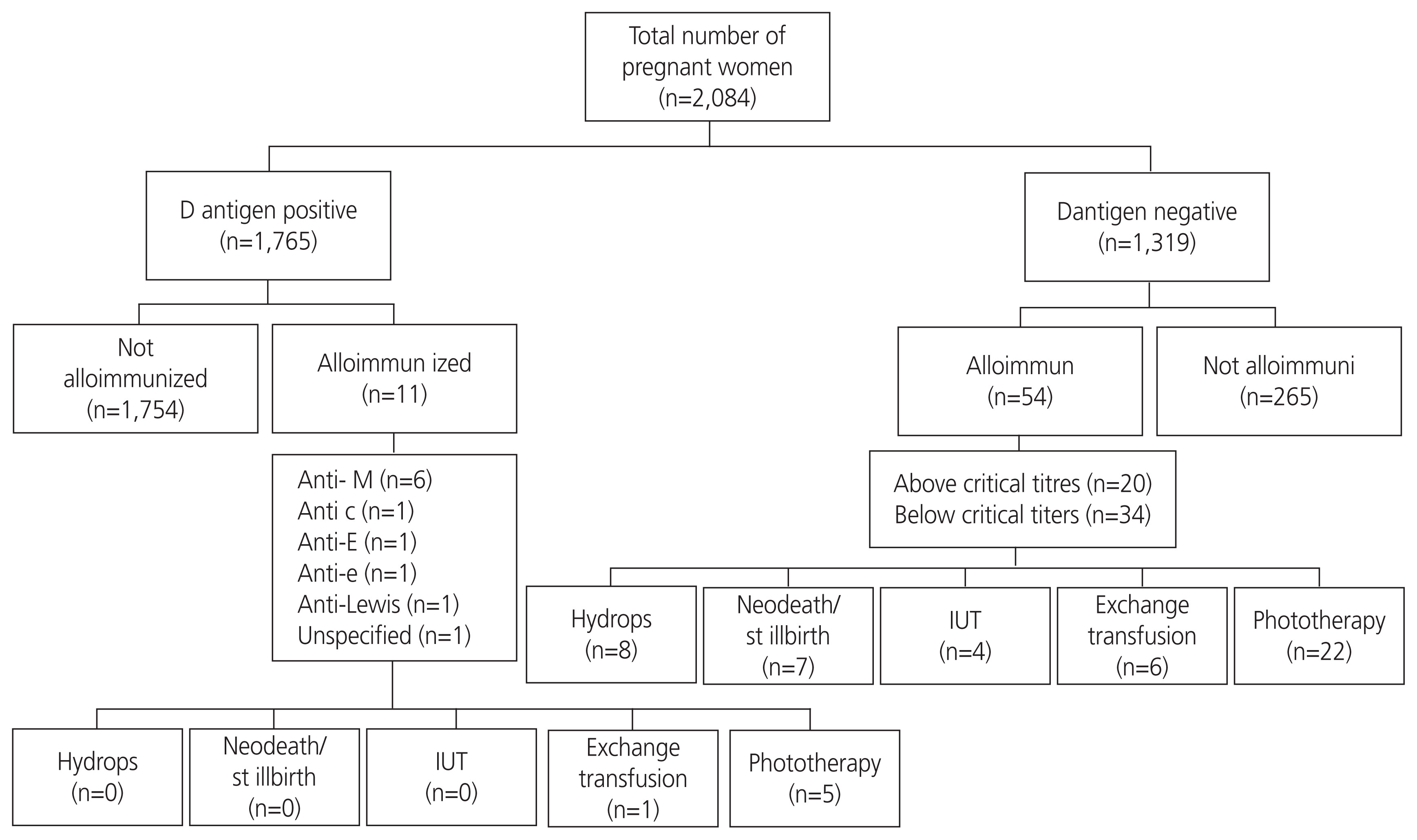1. Rai R, Saha SC, Jain A, Bagga R, Kumar P, Marwaha N. Anti-M alloimmunization in pregnancy: an unusual cause of bad obstetric history. J Obstet Gynaecol India. 2016; 66:607–9.
2. Karim F, Moiz B, Kamran N. Risk of maternal alloimmunization in Southern Pakistan - a study in a cohort of 1000 pregnant women. Transfus Apher Sci. 2015; 52:99–102.
3. Suresh B, Babu KVS, Arun R, Jothibai DS, Bharathi T. Prevalence of “unexpected antibodies” in the antenatal women attending the Government maternity hospital, Tirupati. J Clin Sci Res. 2015; 4:22–30.
4. Basu S, Kaur R, Kaur G. Hemolytic disease of the fetus and newborn: current trends and perspectives. Asian J Transfus Sci. 2011; 5:3–7.
5. Zipursky A, Paul VK. The global burden of Rh disease. Arch Dis Child Fetal Neonatal Ed. 2011; 96:F84–5.
6. Pahuja S, Gupta SK, Pujani M, Jain M. The prevalence of irregular erythrocyte antibodies among antenatal women in Delhi. Blood Transfus. 2011; 9:388.
7. ACOG Practice Bulletin No. 192: management of alloimmunization during pregnancy. Obstet Gynecol. 2018; 131:e82–90.
8. White J, Qureshi H, Massey E, Needs M, Byrne G, Daniels G, et al. Guideline for blood grouping and red cell antibody testing in pregnancy. Transfus Med. 2016; 26:246–63.
9. Varghese J, Chacko MP, Rajaiah M, Daniel D. Red cell alloimmunization among antenatal women attending a tertiary care hospital in south India. Indian J Med Res. 2013; 138:68–71.
10. Das S, Shastry S, Rai L, Baliga PB. Frequency and clinical significance of red cell antibodies in pregnancy - a prospective study from India. Indian J Pathol Microbiol. 2020; 63:241–6.
11. Zipursky A, Bhutani VK. Rhesus disease: a major public health problem. Lancet. 2015; 386:651.
12. Webb J, Delaney M. Red blood cell alloimmunization in the pregnant patient. Transfus Med rev. 2018; 32:213–9.
13. Koelewijn JM, Vrijkotte TG, de Haas M, van der Schoot CE, Bonsel GJ. Risk factors for the presence of nonrhesus D red blood cell antibodies in pregnancy. BJOG. 2009; 116:655–64.
14. Schonewille H, Van De Watering LM, Loomans DS, Brand A. Red blood cell alloantibodies after transfusion: factors influencing incidence and specificity. Transfusion. 2006; 46:250–6.
15. Verduin EP, Brand A, Middelburg RA, Schonewille H. Female sex of older patients is an independent risk factor for red blood cell alloimmunization after transfusion. Transfusion. 2015; 55:1478–85.
16. Koelewijn JM, de Haas M, Vrijkotte TG, van der Schoot CE, Bonsel GJ. Risk factors for RhD immunisation despite antenatal and postnatal anti-D prophylaxis. BJOG. 2009; 116:1307–14.
17. Al-Ibrahim NA, Al Saeed AH. Red blood cell alloimmunization among Saudi pregnant women in the central province of Saudi Arabia. Kuwait Med J. 2008; 40:116–23.
18. de Haas M, Thurik FF, Koelewijn JM, van der Schoot CE. Haemolytic disease of the fetus and newborn. Vox Sang. 2015; 109:99–113.
19. Devi SA, Alwar VA, Sitalakshmi S, Rameshkumar K, Mhaskar R. Red blood cell antibody screening in pregnancy. Asian J Transfus Sci. 2011; 5:56.
20. Jeremiah ZA, Mordi A, Buseri FI, Adias TC. Frequencies of maternal red blood cell alloantibodies in Port Harcourt, Nigeria. Asian J Transfus Sci. 2011; 5:39–41.
21. Kumawat V, Jain A, Sharma RR, Marwaha N. Hemolytic disease of fetus and newborn due to anti-E alloantibody in a newborn of Rh (D)-positive mother. Asian J Transfus Sci. 2012; 6:187.
22. Dholakiya SK, Bharadva S, Vachhani JH, Upadhyay BS. Red cell alloimmunization among antenatal women attending tertiary care center in Jamnagar, Gujarat, India. Asian J Transfus Sci. 2021; 15:52–6.
23. Sánchez-Durán MÁ, Higueras MT, Halajdian-Madrid C, Avilés García M, Bernabeu-García A, Maiz N, et al. Management and outcome of pregnancies in women with red cell isoimmunization: a 15-year observational study from a tertiary care university hospital. BMC Pregnancy Childbirth. 2019; 19:1–8.
24. Altuntas N, Yenicesu I, Himmetoglu O, Kulali F, Kazanci E, Unal S, et al. The risk assessment study for hemolytic disease of the fetus and newborn in a University Hospital in Turkey. Transfus Apher Sci. 2013; 48:377–80.
25. Gottvall T, Filbey D. Alloimmunization in pregnancy during the years 1992–2005 in the Central West region of Sweden. Acta Obstet Gynecol Scand. 2008; 87:843–8.
26. Koelewijn JM, Vrijkotte TG, van der Schoot CE, Bonsel GJ, de Haas M. Effect of screening for red cell antibodies, other than anti-D, to detect hemolytic disease of the fetus and newborn: a population study in the Netherlands. Transfusion. 2008; 48:941–52.




 PDF
PDF Citation
Citation Print
Print




 XML Download
XML Download